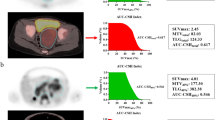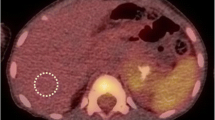Abstract
Background
18F-2-fluoro-2-deoxyglucose (FDG) positron emission tomography (PET) shows tumor activity in most neuroblastomas, but the role of 18F-FDG PET/CT in neuroblastoma remains to be defined.
Objective
This study explored the prognostic significance of 18F-FDG PET in newly diagnosed neuroblastic tumors.
Materials and methods
This retrospective study reviewed all 18F-FDG PET/CT examinations performed for a new diagnosis of suspected neuroblastoma. MYCN amplification status, tumor recurrence and survival were abstracted from the medical record. Primary tumors were manually segmented to measure maximum standardized uptake value (SUVmax), mean standardized uptake value (SUVmean), tumor volume and total lesion glycolysis. Univariate and multivariable analyses using Cox proportional hazards regression testing assessed the predictive performance of PET indices for event-free survival and overall survival with thresholds determined using receiver operating characteristic curve analysis.
Results
Fifty-five children were included, with a median age of 2.9 years (interquartile range [IQR] 1.8–3.0 years). SUVmax, tumor volume and total lesion glycolysis were higher in MYCN-amplified tumors (P=0.012, P<0.0001, P<0.0001, respectively) and in higher International Neuroblastoma Risk Group (INRG) stages (P=0.0008, P=0.0017, P=0.0017, respectively). After adjusting for age, tumor SUVmax (P=0.028) and SUVmean (P=0.045) were associated with overall survival. An SUVmax threshold of 4.77 (P=0.028) best predicted overall survival, with median overall survival of 2,604 days (SUVmax>4.77) vs. >2,957 days (SUVmax≤4.77). No PET parameters were independently significantly associated with overall survival or event-free survival after controlling for MYCN status, stage or treatment risk stratification.
Conclusion
Tumor metabolic activity is higher in higher-stage MYCN-amplified neuroblastic tumors. Higher SUVmax and SUVmean were associated with worse overall survival but were not independent of other prognostic markers.



Similar content being viewed by others
References
Maris JM, Hogarty MD, Bagatell R et al (2007) Neuroblastoma. Lancet 369:2106–2120
Park JR, Kreissman SG, London WB et al (2019) Effect of tandem autologous stem cell transplant vs. single transplant on event-free survival in patients with high-risk neuroblastoma: a randomized clinical trial. JAMA 322:746–755
Monclair T, Brodeur GM, Ambros PF et al (2009) The international neuroblastoma risk group (INRG) staging system: an INRG task force report. J Clin Oncol 27:298–303
Liu Y-L, Lu M-Y, Chang H-H et al (2016) Diagnostic FDG and FDOPA position emission tomography scans distinguish the genomic type and treatment outcome of neuroblastoma. Oncotarget 7:18774–18786
Kushner BH, Yeung HW, Larson SM et al (2001) Extending positron emission tomography scan utility to high-risk neuroblastoma: fluorine-18 fluorodeoxyglucose positron emission tomography as sole imaging modality in follow-up of patients. J Clin Oncol 19:3397–3405
Sharp SE, Shulkin BL, Gelfand MJ et al (2009) 123I-MIBG scintigraphy and 18F-FDG PET in neuroblastoma. J Nucl Med 50:1237–1243
Lee JW, Cho A, Yun M et al (2015) Prognostic value of pretreatment FDG PET in pediatric neuroblastoma. Eur J Radiol 84:2633–2639
Kang SY, Rahim MK, Kim Y-I et al (2016) Clinical significance of pretreatment FDG PET/CT in MIBG-avid pediatric neuroblastoma. Nucl Med Mol Imaging 51:154–160
Papathanasiou ND, Gaze MN, Sullivan K et al (2011) 18F-FDG PET/CT and 123I-metaiodobenzylguanidine imaging in high-risk neuroblastoma: diagnostic comparison and survival analysis. J Nucl Med 52:519–525
Liu C-J, Lu M-Y, Liu Y-L et al (2017) Risk stratitfication of pediatric patients with neuroblastoma using volumetric parameters of 18F-FDG and 18F-DOPA PET/CT. Clin Nucl Med 42:e142–e148
Author information
Authors and Affiliations
Corresponding author
Ethics declarations
Conflicts of interest
None
Additional information
Publisher’s note
Springer Nature remains neutral with regard to jurisdictional claims in published maps and institutional affiliations.
Rights and permissions
About this article
Cite this article
Sung, A.J., Weiss, B.D., Sharp, S.E. et al. Prognostic significance of pretreatment 18F-FDG positron emission tomography/computed tomography in pediatric neuroblastoma. Pediatr Radiol 51, 1400–1405 (2021). https://doi.org/10.1007/s00247-021-05005-y
Received:
Revised:
Accepted:
Published:
Issue Date:
DOI: https://doi.org/10.1007/s00247-021-05005-y




